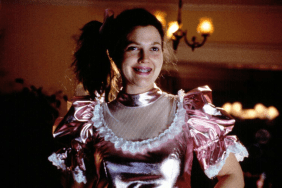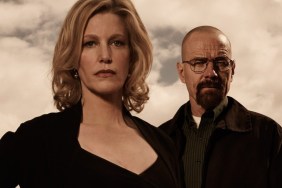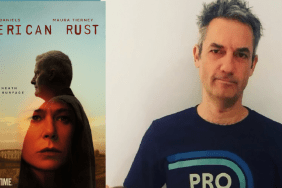The thriller opening September 24

Buried (opening this Friday in limited release and going wide October 8) is a modern-day thriller in a Hitchcockian vein, where American contractor Paul Conroy is buried in a coffin somewhere in Iraq. From within the confines of the box he has to piece together why he’s buried, who buried him, and how he can get himself dug up. With only a cell phone and a few other critical objects he fights for his survival within the unfolding universe of danger both inside and outside the box.
The film takes place entirely within the coffin where actor Ryan Reynolds has to sustain the story all on his own, with no cutaways or fancy editing to fall back on. It is a thrilling concept executed with great aplomb by director Rodrigo Cortés, who piles on the suspense layer after layer until it is literally at the breaking point.
Ryan Reynolds talked about the challenges of the film in New Yorkâ¦
Shock Till You Drop: Were you before or are you now at all claustrophobic and how did you deal with that?
Ryan Reynolds: Claustrophobia is a primal fear that exists within everybody. This is probably most human being’s worst nightmare come true, to be buried alive. I couldn’t help but feel that when we were shooting, we were using a coffin. There were very few tricks. The greatest tricks were slight-of-hand engineered by Mr. Rodrigo Cortés. For me I was enclosed in there and had moments of utter panic that were soothed in various ways. One woman was playing all the roles when we were shooting. I had a microphone close to my chest and she could hear my panic attack starting âcause she could hear my heart accelerating. There were times when I couldn’t get out of the coffin with any ease so I just had to stay in there with 50-60 pounds of wood on your chest pressing down so you start to have moments of panic. She would talk about wide open spaces, meadows, trees, things like that, esoteric stuff that would chill me out and allow me to my job.

Shock: What sort of prep did you do for the role?
Reynolds: Prep-wise there’s not a lot you can do. This guy’s experiencing something extraordinary. I couldn’t actually imagine what that was like, so for me most of the prep happened moments before. I wanted to get inside and see if the shoe fit, I jumped in the coffin, “yep, it fits, let’s go.” That was really it. The prep I did was layering in some unlikable traits with the character as opposed to him being this wonderful human being. There needs to be something that draws you in that this is a real person, someone you may not want to have a beer with if he ever gets to the surface. The human condition is to empathize, because of that no matter who he is we want this guy to get up to the surface so we can hug him, punch him out, or do whatever. Whatever our personal feelings with this guy we want to see him live.
Shock: This movie touches on so many important issues. Is there one in particular you were drawn to?
Reynolds: Gosh, there’s a lot of issues. For me the movie speaks more about communication and how we feel so safe with that, we feel like we’re connected 100% of the time, all the time, and we are, we have Blackberries, mobile phones. There’s a hidden enemy, and in this case it’s not a terrorist, it’s not limited oxygen supply, it’s not a coffin, it’s bureaucracy. That can kill a person, it’s killing Paul Conroy in this film. That to me spoke volumes about the world we live in. “Press one for help in Spanish, press two for help in English.” You can’t get a human being on the phone any more, even in an emergency.

Shock: Have you ever had any post-traumatic experiences or similar instances to draw from?
Reynolds: I didn’t really have a lot of post-traumatic stress instances in my own life that I can draw upon that would even remotely help me in a situation like this, but I think we’ve all had moments where we felt out of control, and I’ve certainly had my moments where I felt out of control. You try to tap into that to the best of your ability and put it on the screen. For me the primary goal in this situation is to be as honest at every moment in the film as possible. There’s no right or wrong way to say a line or perform a scene. As long as it’s truthful the audience is going to stay with this guy. That was my only job.
Shock: You have such a diverse resume of films. What do you do differently to prepare for something like Buried as opposed to something like Green Lantern?
Reynolds: A movie like Buried is so psychological and so terrifying, and it’s really a more emotional preparation. A movie like Green Lantern is spending 5 months doing gymnastics, and when you’re 6-foot-2 that just shouldn’t be done. [laughs] I’ve been lucky thus far. I have an ability that I’ve used throughout my career, I’m fortunate to have that, but most of it is dumb luck. I had a career that allowed me to do a number of different things early on, and because of that I never had this meteoric success early on. I wasn’t a 19-year-old kid on the cover of every magazine. I was in the industry but I wasn’t of the industry. It really allowed me to have an outside perspective and I was able to mature in a normal way like a career should. In my early 30s, where I am now, I’m afforded an opportunity to do a movie like Buried and then a movie like Green Lantern in the same year. I’m going to keep trying to do that as long as they’ll let me.

Shock: The film was shot over the course of 17 days, but it actually takes place in only a few hours. How did you keep that sense of immediacy and impending danger over such a protracted shoot?
Reynolds: I’ll tell you one thing, we shot this film chronologically, and that almost never, ever happens. Because of that we really had a great sense of where we just came from and where we were going at any given point. I don’t know if a film like this would be possible if we weren’t given this gift of being able to go in order.
Shock: Did you feel like the emotional aspects where more difficult or the technical aspects? I know you had to keep the lighting on youâ¦
Reynolds: Yes, those things were. I was the unofficial gaffer of the film, so I had to light myself in a lot of the scenes and I had to create that sense of atmosphere using just the lighter or just the cell phone or just the glow stick. Whatever is available at the time. Rodrigo shot an action sequence inside the coffin at one point, all sorts of elements. You have a mysterious visitor who shows up, you have fire in one scene. Basically in the space of 35-seconds he turns a movie about a guy in a box into Indiana Jones. In those moments it’s very difficult because I have to light the scene, I have to create these elements at that point, and I have to break down and lose my mind and scream and shout or whatever is happening. It’s kind of balancing those things and trying to hit all of those points. You just try not to think about it so much. I take the information that Rodrigo gave me and try to get as many of those things he asked for into the ten-second window and hopefully some of them will stick.




Source: Max Evry









